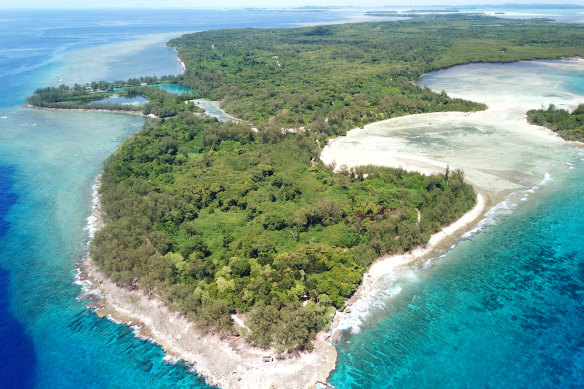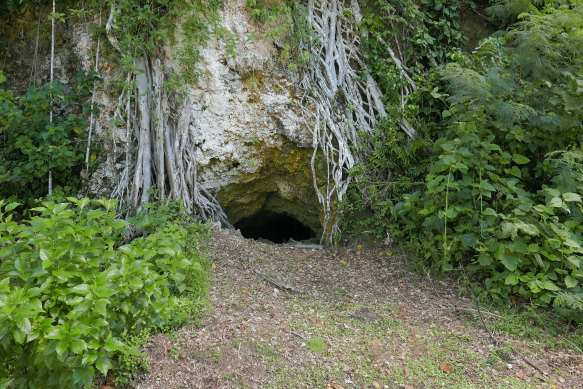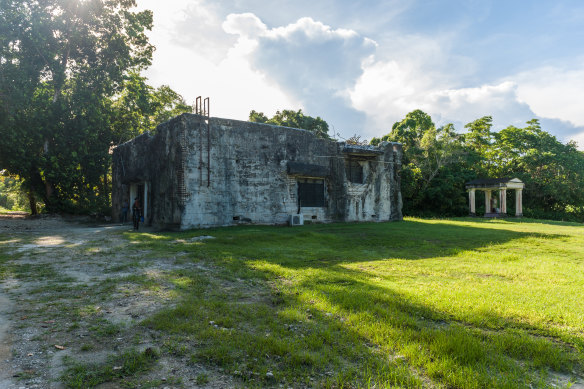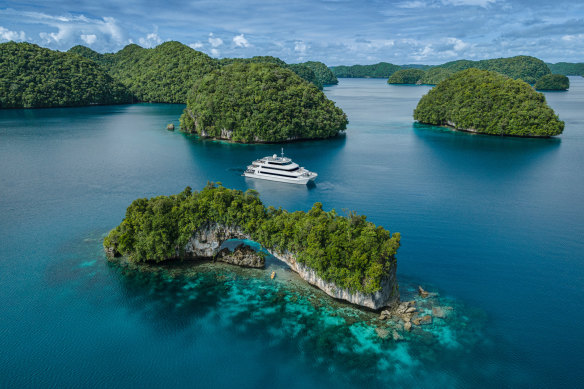This was published 1 year ago
The forgotten island where an Australian legend was killed
In the dim torchlight, Des Matsutaro crouches over the unremarkable detritus of war. Beer bottles, pots, a shoe sole, bowls stamped with the insignia of the Imperial Japanese Navy. A land crab scurries across the dusty floor, which is littered with ammunition cases, and a “drip pit” for capturing bodily fluids hints at a makeshift operating room.

The island of Peleliu played host to one of the fiercest battles of World War II.Credit: iStock
The 1000-Man Cave on the island of Peleliu, in the Micronesian nation of Palau, echoes war stories as grisly as they get. Of thousands of Japanese soldiers hiding out in an ant farm of underground caves and tunnels, and of the American forces armed with flamethrowers and bulldozers, who entombed many.

Australian war correspondent Damien Parer.Credit: Mitchell Library, State Library of New South Wales
This September marks the 80th anniversary of the Battle of Peleliu, described by some veterans as the fiercest of the Pacific campaign.
It’s also where the famous Australian war correspondent Damien Parer died while filming the US invasion. Parer, whose Academy Award-winning footage of Kokoda produced some of the most iconic images of Australian troops in WWII, was killed by Japanese gunfire on September 17, 1944, aged 33. He left behind a wife of six months and an unborn son.
Unlike Gallipoli and Fromelles, Palau isn’t a war-history destination for Australians. The few who visit the archipelago – a chain of 340-odd islands scattered 1500 kilometres south-east of the Philippines – come for the UNESCO World Heritage-listed Rock Islands and their superlative coral reefs. But journey to Peleliu, a coral island 10 kilometres long and half as wide, and a forgotten story of the war unfolds.

The entrance to 1000 Man Cave.Credit: iStock
My visit is part of a half-day excursion with Four Seasons Explorer, a unique “floating resort” permanently based in Palau since October. We’re met by Des, a travel guide and historian of Palauan and Japanese descent, who takes us on a journey – part cycled/part driven – through Peleliu’s darkest days.
He describes how, on September 15, 1944, US troops stormed the island’s south-west beaches in a coordinated land, sea and aerial strike to seize Palau’s only airfield. The allies needed aerial support for the invasion of Japanese-occupied Philippines, and Palau – a former German colony administered by Japan after WWI – was a strategic foothold.
“It was only supposed to last a number of days,” Des says of the Peleliu campaign. “Unfortunately the battle raged on for almost three months.” We visit the landings where US troops in “amtraks” (amphibious tractors) charged ashore in a hail of gunfire. It took them 12 hours to reach the airfield, a few hundred metres inland, and three weeks to secure it.
Parer died on day three while trying to film the faces of advancing US marines. His remains are in Ambon War Cemetery in Indonesia, and the Australian Embassy is considering a Palau memorial for the 80th anniversary.
The battle for Peleliu formed a major part of HBO’s Band of Brothers 2010 companion series The Pacific, which was filmed in Australia.

The now-condemned war museum is housed in an old bunker.Credit: iStock
Now a graveyard of war dead, almost 11,000 Japanese soldiers are buried in mass graves on the island, with thousands still considered missing in action.
Behind the landing beaches, a stone memorial replaces a field of white crosses where 1058 US soldiers were buried (and later repatriated) in the first two months of the campaign. Grainy black and white images show a tropical landscape reduced to a dust bowl.
Today, the jungle has reclaimed Peleliu, its tendrils creeping through the rusted carcasses of amtraks and planes, over pillboxes and bunkers and around a 200-millimetre long-range gun embedded in a hillside. But it remains one of the world’s best-preserved battlefields, Des says.
We explore the airfield, the recently condemned old fuel depot-turned museum, and the crumbling remains of the Japanese headquarters – pockmarked with bullets and twice hit by B24 bombers – its collapsed ceiling surrendering to creeping vines.
The most poignant site is the limestone ridge extending three-quarters of the way down the island’s spine and honeycombed with Japanese-built tunnels and caves. It’s nicknamed Bloody Nose Ridge because, by the latter stages of the fighting, many soldiers, depleted of ammunition, resorted to hand-to-hand combat.

Four Seasons Explorer is permanently based in Palau.
“This island, when we returned, was an island beyond recognition,” Des says. “We’ve never seen destruction like this in our history.”
THE DETAILS
Fly
Air Niugini flies to Palau’s commercial hub, Koror, weekly from Brisbane via Port Moresby.
airniugini.com.pg
Stay
The Four Seasons Explorer has 10 staterooms and one suite, with daily check-in and check-out. fourseasons.com/explorerpalau
Tour
Peleliu Adventures runs historical tours of the island. visitpeleliu.com
The writer was a guest of Four Seasons Explorer.
Sign up for the Traveller Deals newsletter
Get exclusive travel deals delivered straight to your inbox. Sign up now.